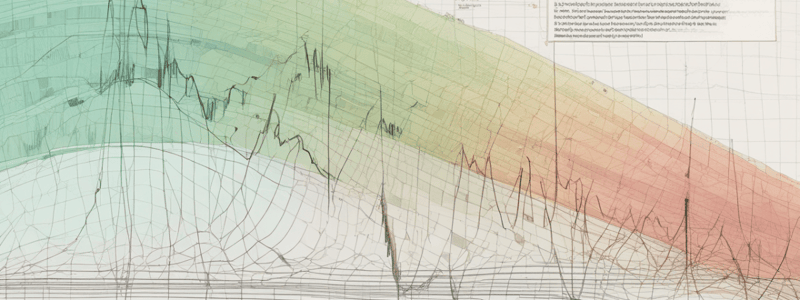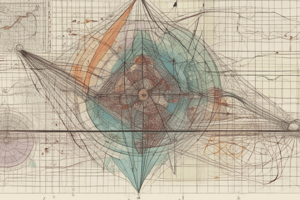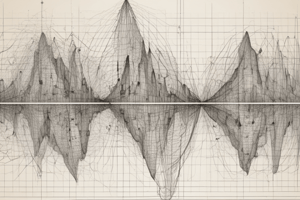Podcast
Questions and Answers
What is the primary purpose of a graph in maths literacy?
What is the primary purpose of a graph in maths literacy?
- To compare two different datasets
- To calculate the average of a dataset
- To identify the median of a dataset
- To display relationships between two variables (correct)
What type of graph would show a quicker change?
What type of graph would show a quicker change?
- Gradual Slope
- Increasing Graph
- Steep Slope (correct)
- Decreasing Graph
What is the main difference between a continuous graph and a discrete graph?
What is the main difference between a continuous graph and a discrete graph?
- The shape of the graph
- The type of variables used
- The type of data plotted (correct)
- The scale of the graph
What is the dependent variable in a graph?
What is the dependent variable in a graph?
What happens when a graph touches the horizontal axis?
What happens when a graph touches the horizontal axis?
What is the purpose of identifying patterns in a graph?
What is the purpose of identifying patterns in a graph?
What is the main difference between an increasing graph and a decreasing graph?
What is the main difference between an increasing graph and a decreasing graph?
What is the purpose of writing a general formula in maths literacy?
What is the purpose of writing a general formula in maths literacy?
What is the main purpose of graphs in Mathematical Literacy?
What is the main purpose of graphs in Mathematical Literacy?
What does a steeper slope on a graph indicate?
What does a steeper slope on a graph indicate?
What is the formula for a linear relationship?
What is the formula for a linear relationship?
What is the dependent variable in a graph?
What is the dependent variable in a graph?
What does a graph with a curve indicate?
What does a graph with a curve indicate?
What is the formula for an inverse proportion relationship?
What is the formula for an inverse proportion relationship?
What is the first step in plotting points on a grid?
What is the first step in plotting points on a grid?
What is the purpose of identifying patterns in data?
What is the purpose of identifying patterns in data?
What is the general formula for writing rules for patterns?
What is the general formula for writing rules for patterns?
What is the formula for a linear pattern rule?
What is the formula for a linear pattern rule?
Study Notes
Understanding Graphs
- Graphs display relationships between two variables, making data easier to interpret visually.
- They can show trends, such as the increase or decrease in prices over time.
Graphs in Maths Literacy
- Interpret the messages conveyed by graphs.
- Identify patterns in number relationships.
- Distinguish between linear (straight-line) and inverse (curved) relationships in graphs.
- Develop formulae for patterns observed in tables and graphs.
Features of Graphs
- Increasing Graphs: Slope goes up from left to right, indicating a rise in values.
- Decreasing Graphs: Slope goes down from left to right, indicating a decline in values.
- Steep Slope: Indicates a quicker change.
- Gradual Slope: Indicates a slower change.
Continuous vs. Discrete Graphs
- Continuous Graphs: Represent measurements that can take any value within a range, connected by solid lines.
- Discrete Graphs: Represent whole numbers, shown by points connected by dotted lines.
Interpreting Graphs
- Independent Variable: Stands alone and isn't affected by other variables (e.g., time).
- Dependent Variable: Changes in response to the independent variable (e.g., distance travelled).
- Vertical Axis (Y-Axis): When the graph touches this axis, it indicates the starting value of the dependent variable.
- Horizontal Axis (X-Axis): When the graph touches this axis, it indicates the dependent variable has reached zero.
Finding Patterns and Formulas
- Identifying Patterns: Look for consistent changes in the data to identify patterns.
- Writing General Formulas: Use variables to represent the general rule for a pattern.
Pattern Representation
-
Linear Relationships: Form straight lines on a graph, identified by a constant rate of change.
-
Formula: y = mx + c
- y: Dependent variable
- m: Slope of the line (rate of change)
- x: Independent variable
- c: Y-intercept (starting value when x = 0)
-
Inverse Proportions: Form curves on a graph, as one quantity increases, the other decreases.
-
Formula: y = k/x
- y: Dependent variable
- k: Constant of proportionality
- x: Independent variable
Plotting Points
- Step 1: Start at the origin (0,0).
- Step 2: Move along the horizontal x-axis to the first number of the ordered pair.
- Step 3: Move up along the vertical y-axis to the second number of the ordered pair.
- Step 4: Plot the point where the two lines intersect.
Studying That Suits You
Use AI to generate personalized quizzes and flashcards to suit your learning preferences.




